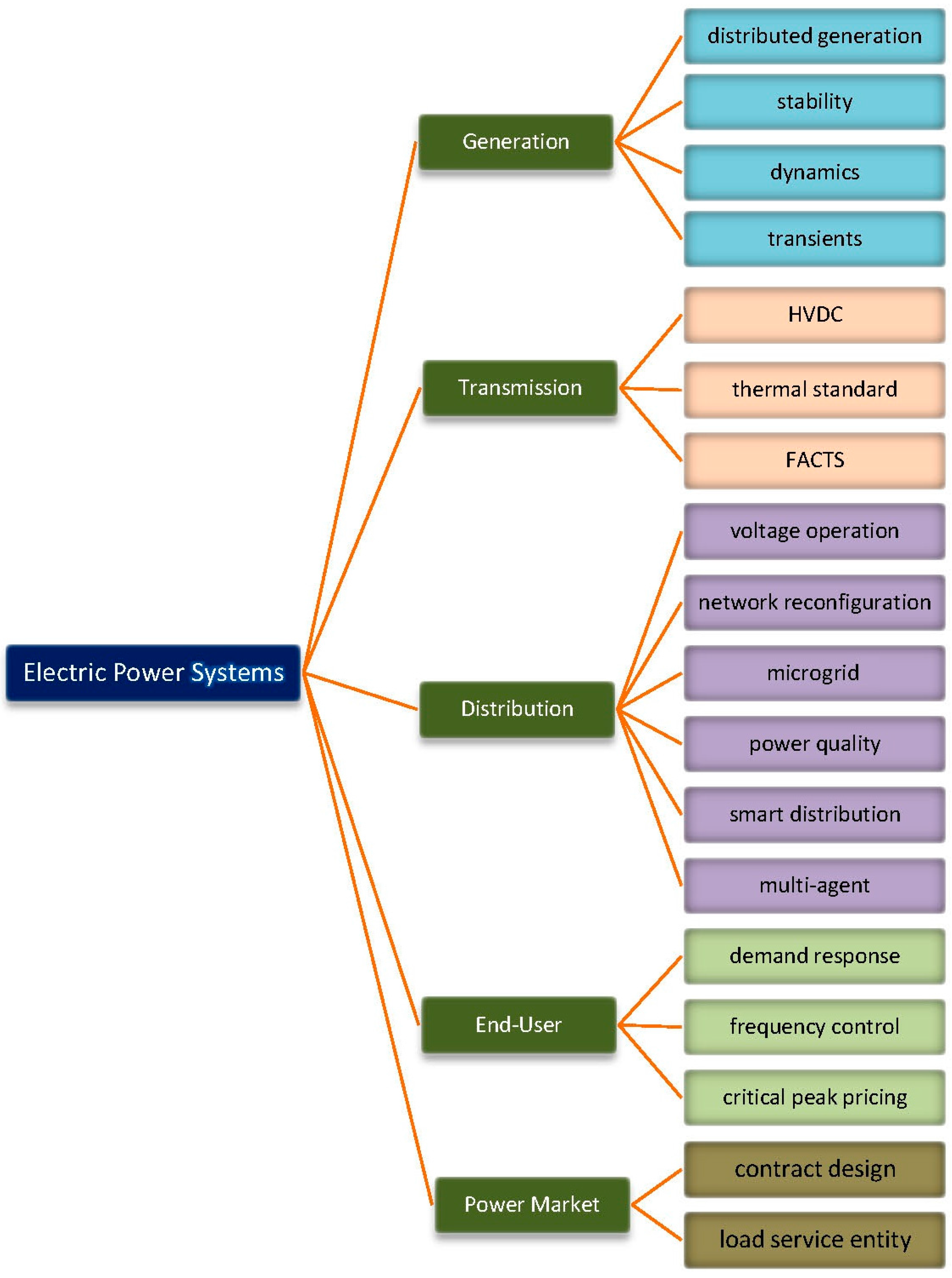Electric Power Systems Research
- (1)
- Power system stability;
- (2)
- Power system reliability;
- (3)
- Flexible alternating current transmission systems (FACTS) applied to power systems;
- (4)
- Application of optimization methods to power systems;
- (5)
- Architectures and models of smart grids;
- (6)
- Power market;
- (7)
- Control, operation, and planning of distributed generation resources;
- (8)
- Smart home with energy management systems;
- (9)
- Microgrids and active distribution networks;
- (10)
- Virtual power plants and demand response.
Conflicts of Interest
References
- Hu, B.; Sun, J.; Ding, L.; Liu, X.; Wang, X. Dynamic equivalent modeling for small and medium hydropower generator group based on measurements. Energies 2016, 9, 362. [Google Scholar] [CrossRef]
- Huang, C.; Yue, D.; Xie, X.; Xie, J. Anti-windup load frequency controller design for multi-area power system with generation rate constraint. Energies 2016, 9, 330. [Google Scholar] [CrossRef]
- Wu, G.; Ju, P.; Song, X.; Xie, C.; Zhong, W. Interaction and coordination among nuclear power plants, power grids and their protection systems. Energies 2016, 9, 306. [Google Scholar] [CrossRef]
- Zhao, Y.; Li, Z.; Nie, Y. A time-frequency analysis method for low frequency oscillation signals using resonance-based sparse signal decomposition and a frequency slice wavelet transform. Energies 2016, 9, 151. [Google Scholar] [CrossRef]
- Oh, S.; Chae, S. A co-simulation framework for power system analysis. Energies 2016, 9, 131. [Google Scholar] [CrossRef]
- Sima, W.; Zou, M.; Yang, Q.; Yang, M.; Li, L. Field experiments on 10 kV switching shunt capacitor banks using ordinary and phase-controlled vacuum circuit breakers. Energies 2016, 9, 88. [Google Scholar] [CrossRef]
- Yang, S.; Zeng, D.; Ding, H.; Yao, J.; Wang, K.; Li, Y. Multi-objective demand response model considering the probabilistic characteristic of price elastic load. Energies 2016, 9, 80. [Google Scholar] [CrossRef]
- Yoon, M.; Yoon, Y.; Jang, G. A study on maximum wind power penetration limit in island power system considering high-voltage direct current interconnections. Energies 2015, 8, 14244–14259. [Google Scholar] [CrossRef]
- Yu, Y.; Jin, T.; Zhong, C. Designing an incentive contract menu for sustaining the electricity market. Energies 2015, 8, 14197–14218. [Google Scholar] [CrossRef]
- Kang, H.; Chung, I.; Moon, S. Voltage control method using distributed generators based on a multi-agent system. Energies 2015, 8, 14009–14025. [Google Scholar] [CrossRef]
- Huang, W.; Chen, T.; Chen, H.; Yang, J.; Lian, K.; Chang, Y.; Lee, Y.; Ho, Y. A two-stage optimal network reconfiguration approach for minimizing energy loss of distribution networks using particle swarm optimization algorithm. Energies 2015, 8, 13894–13910. [Google Scholar] [CrossRef]
- Arroyo, A.; Castro, P.; Martinez, R.; Manana, M.; Madrazo, A.; Lecuna, R.; Gonzalez, A. Comparison between IEEE and CIGRE thermal behaviour standards and measured temperature on a 132-kV overhead power line. Energies 2015, 8, 13660–13671. [Google Scholar] [CrossRef]
- Wang, H.; Zhang, B.; Hao, Z. Response based emergency control system for power system transient stability. Energies 2015, 8, 13508–13520. [Google Scholar] [CrossRef]
- Cai, C.; Jiang, B.; Deng, L. General dynamic equivalent modeling of microgrid based on physical background. Energies 2015, 8, 12929–12948. [Google Scholar] [CrossRef]
- Villena, J.; Vigueras-Rodríguez, A.; Gómez-Lázaro, E.; Fuentes-Moreno, J.; Muñoz-Benavente, I.; Molina-García, A. An analysis of decentralized demand response as frequency control support under critical wind power oscillations. Energies 2015, 8, 12881–12897. [Google Scholar] [CrossRef]
- Liao, S.; Li, Z.; Li, G.; Wang, J.; Wu, X. Modeling and optimization of the medium-term units commitment of thermal power. Energies 2015, 8, 12848–12864. [Google Scholar] [CrossRef]
- Kim, S.; Overby, T. Optimal subinterval selection approach for power system transient stability simulation. Energies 2015, 8, 11871–11882. [Google Scholar] [CrossRef]
- Park, S.; Jin, Y.; Yoon, Y. Designing a profit-maximizing critical peak pricing scheme considering the payback phenomenon. Energies 2015, 8, 11363–11379. [Google Scholar] [CrossRef]
- Zhang, R.; Chu, X.; Zhang, W.; Liu, Y. Active participation of air conditioners in power system frequency control considering users’ thermal comfort. Energies 2015, 8, 10818–10841. [Google Scholar] [CrossRef]
- Moon, J.-H.; Kang, S.-H.; Ryu, D.-H.; Chang, J.-L.; Nam, S.-R. A two-stage algorithm to estimate the fundamental frequency of asynchronously sampled signals in power systems. Energies 2015, 8, 9282–9295. [Google Scholar] [CrossRef]
- Hong, Y.Y.; Hsieh, Y.L. Interval type-II fuzzy rule-based STATCOM for voltage regulation in the power system. Energies 2015, 8, 8908–8923. [Google Scholar] [CrossRef]
- Jiang, Y.; Liu, C.C.; Xu, Y. Smart distribution systems. Energies 2016, 9, 297. [Google Scholar] [CrossRef]

© 2016 by the author; licensee MDPI, Basel, Switzerland. This article is an open access article distributed under the terms and conditions of the Creative Commons Attribution (CC-BY) license (http://creativecommons.org/licenses/by/4.0/).
Share and Cite
Hong, Y.-Y. Electric Power Systems Research. Energies 2016, 9, 824. https://doi.org/10.3390/en9100824
Hong Y-Y. Electric Power Systems Research. Energies. 2016; 9(10):824. https://doi.org/10.3390/en9100824
Chicago/Turabian StyleHong, Ying-Yi. 2016. "Electric Power Systems Research" Energies 9, no. 10: 824. https://doi.org/10.3390/en9100824





